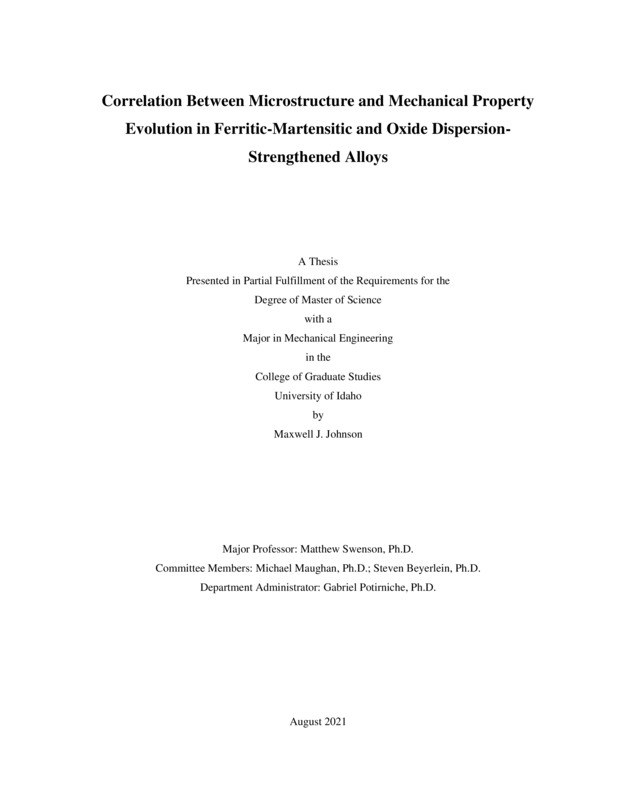Correlation Between Microstructure and Mechanical Property Evolution in Ferritic-Martensitic and Oxide Dispersion- Strengthened Alloys
Johnson, Maxwell Joseph. (2021-08). Correlation Between Microstructure and Mechanical Property Evolution in Ferritic-Martensitic and Oxide Dispersion- Strengthened Alloys. Theses and Dissertations Collection, University of Idaho Library Digital Collections. https://www.lib.uidaho.edu/digital/etd/items/johnson_idaho_0089n_12132.html
- Title:
- Correlation Between Microstructure and Mechanical Property Evolution in Ferritic-Martensitic and Oxide Dispersion- Strengthened Alloys
- Author:
- Johnson, Maxwell Joseph
- Date:
- 2021-08
- Program:
- Mechanical Engineering
- Subject Category:
- Mechanical engineering
- Abstract:
-
With the rising global demand for low-cost clean energy, nuclear fission and fusion systems willbecome increasingly important sources for both economic and environmental reasons. These new advanced systems will operate at a higher efficiency compared to previous models. This will require materials to be long-lasting durable and have excellent high-temperature performance (up to 700°C) under adverse conditions. Qualities such as resistance to oxidation, resistance to swelling, and low levels of radioactivation will be critical for any material used in nuclear reactor components, specifically for fuel cladding or structural elements surrounding the reactor core. Materials research historically focused on austenitic stainless steels, superalloys, or ferritic-martensitic (F-M) steels. This study focuses on three FM steels, HT-9, HCM12A, T91, and one ODS alloy, MA956. In order to understand the effects of irradiation, charged particle irradiation is used to imitate the damage on these candidate materials. To better understand the effects of irradiation, the dispersed barrier hardening, solid solution strengthening, and grain size dependence (Hall-Petch) models are used to quantify the strengthening caused by irradiation induced micro-, and nano-structure features. Coupled with nanoindentation, transmission electron microscopy (TEM), and atom probe tomography (APT), irradiation induced features can be numericized, and evaluated on the significant changes they contribute to the overall change in strength of the material.
- Description:
- masters, M.Engr., Mechanical Engineering -- University of Idaho - College of Graduate Studies, 2021-08
- Major Professor:
- Swenson, Matthew
- Committee:
- Maughan, Michael; Beyerlein, Steven
- Defense Date:
- 2021-08
- Identifier:
- Johnson_idaho_0089N_12132
- Type:
- Text
- Format Original:
- Format:
- application/pdf
- Rights:
- In Copyright - Educational Use Permitted. For more information, please contact University of Idaho Library Special Collections and Archives Department at libspec@uidaho.edu.
- Standardized Rights:
- http://rightsstatements.org/vocab/InC-EDU/1.0/

